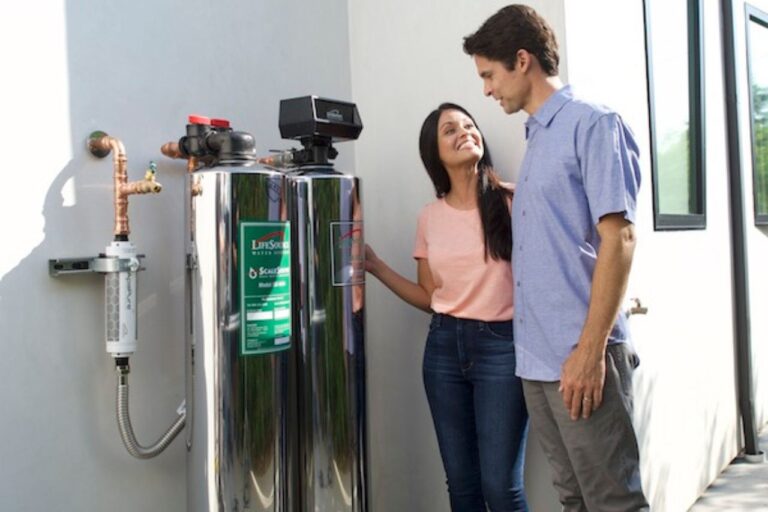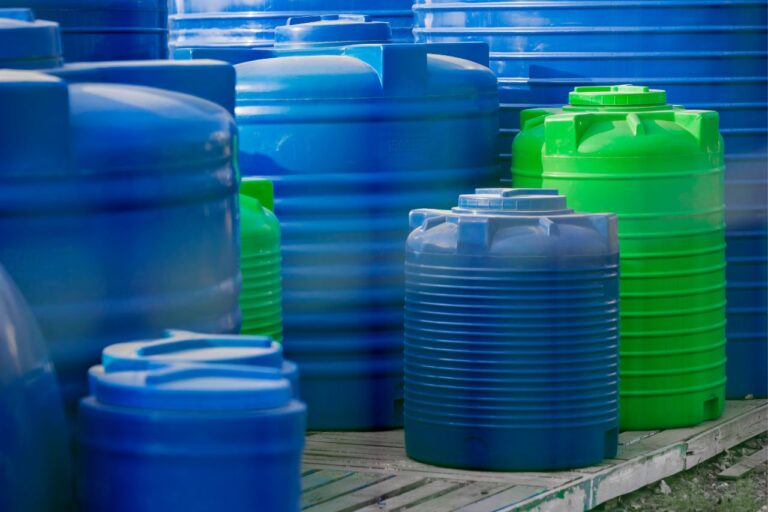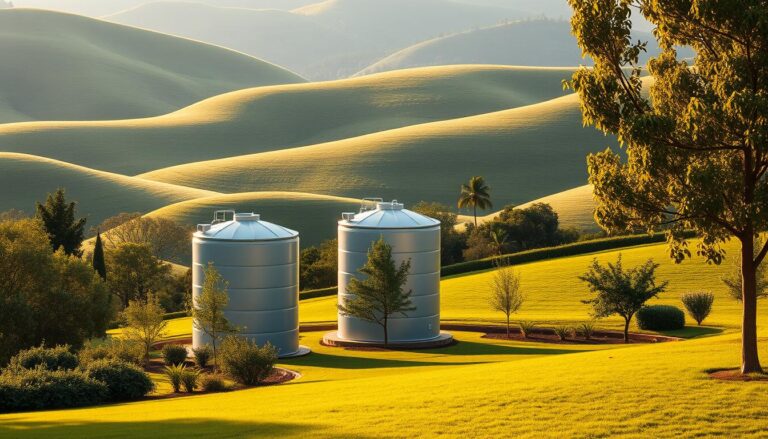Effective Strategies for Storing Water Long-Term
Water is key to survival. Knowing how to store water long term can save lives in emergencies. This guide shares simple, effective ways to keep your family safe. Whether facing natural disasters or unexpected outages, learning water storage methods is crucial. It ensures you have clean water when taps stop working.

Key Takeaways
- Plan for at least one gallon of water per person daily for emergencies.
- Food-grade containers are a top choice for storing water for emergencies.
- Regular checks and rotation extend the shelf life of stored water.
- Ultraviolet light or bleach treatments help keep water safe over time.
- Space-saving solutions exist even in small homes or apartments.
Why Long-Term Water Storage is Essential for Every Household
When disaster hits, having clean water can be a lifesaver. Storing water for emergencies is more than just a precaution—it’s crucial. Without enough water, even the best food supplies are useless. Making sure you have safe water preservation means your family can stay hydrated and healthy during tough times.
Understanding Water’s Role in Emergency Preparedness
Humans can last weeks without food but only days without water. Each person needs at least 1 gallon of water daily for drinking and keeping clean. Using the right water storage methods keeps this essential resource ready for emergencies like earthquakes or hurricanes. Clean water helps prevent dehydration and keeps us healthy when public water systems fail.
FEMA Recommendations for Household Water Supplies
- Store 1 gallon per person per day for at least 3 days.
- Use FDA-approved containers or commercial water drums.
- Rotate supplies every six months for safe water preservation.
FEMA’s advice is to make sure you have enough water for emergencies. Their guidelines are based on successful water storage methods used in disasters across the country.
Real-Life Scenarios Where Stored Water Saved Lives
“Our stored water kept us alive for a week after Hurricane Irma flooded local wells.” – Maria, Florida resident
In 2021, Texas winter storms showed how important stored water is. Families with water avoided contaminated pipes. During California wildfires, bottled water helped evacuees stay hydrated. These examples prove FEMA’s point: storing water for emergencies is not optional—it’s a must. Taking these steps now will protect your family’s well-being.
How Much Water Should You Store for Different Situations
First, figure out your family’s daily water needs. The how to store water long term starts with one gallon per person each day. But, adjust this based on your family’s specific needs.
- Family size: Multiply 1 gallon/day by the number of people.
- Climate: Add 25% extra in hot or dry areas.
- Medical needs: Increase by 50% for those with health conditions.
| Time Period | Per Person | Family of 4 | Notes |
|---|---|---|---|
| 3 Days | 3 gallons | 12 gallons | Emergency kits require this minimum. |
| 2 Weeks | 14 gallons | 56 gallons | Add 20% more in extreme heat. |
| 1 Month | 30 gallons | 120 gallons | Include extra for hygiene and cooking. |
| 3 Months | 90 gallons | 360 gallons | Use durable water storage systems for large quantities. |
Pets need 1/2 gallon daily. Check your water storage methods often and update totals as family needs change. For long-term plans, pair calculations with reliable containers and rotation schedules.
Best Containers for Long-Term Water Storage
Choosing the right water storage containers keeps your water safe and easy to get to. Each material has its own benefits, based on your space, budget, and needs.
Food-Grade Plastic Containers: Pros and Cons
- BPA-free plastics: Look for long-lasting water storage solutions like NSF-certified #2 HDPE or #4 LDPE.
- Lightweight and affordable: Brands like Rubbermaid offer opaque options blocking light to prevent algae.
- Downsides: May degrade in sunlight; replace every 5-7 years.
Glass Options: Benefits and Limitations
Glass is great because it doesn’t leach chemicals. A 5-gallon jug can hold 40 servings, perfect for small batches.
| Pros | Cons |
|---|---|
| No chemical leaching | Heavy and fragile |
| Pure taste retention | High storage space demand |
Metal Containers: When to Use and When to Avoid
Stainless steel (like those from Camp Chef) is durable but pricier. Avoid thin aluminum unless it’s coated to prevent taste transfer.
Water Barrels and Tanks for Larger Storage Needs
Heavy-duty barrels (e.g., 55-gallon FoodSaver models) are great for outdoor use. Use food-grade water storage systems with spigots for easy access. Store in shaded areas to slow algae growth.
How to Store Water Long Term: Step-by-Step Guide
Learning how to store water long term is all about being organized and precise. Follow these steps to keep your water supply safe and easy to access for years.
Selecting the Right Location
Find a cool, dark place away from sunlight and extreme temperatures. Basements or closets are great. Make sure heavy containers are on sturdy shelves or the floor to avoid them tipping over. Keep the area dry to stop mold from growing. Best practices for storing water also mean making sure you can easily get to it during emergencies. Never bury containers where they’re hard to reach.
Proper Cleaning and Sanitization Procedures
New containers need a rinse with soapy water. For containers you’ve used before, follow these steps:
- Wash with dish soap and warm water.
- Rinse thoroughly.
- Sanitize with a solution of 1 teaspoon unscented bleach per quart of water. Soak for 2 minutes, then rinse again.
This makes sure there’s no residue that could harm the water.
Filling and Sealing Methods
Fill containers all the way to the top to reduce air exposure. Use clean funnels to avoid getting dirt in. Seal them tightly with the original lids, making sure they’re fully tightened. Store them upright. For preserving water for the long term, label each container with the date and volume. Check the seals monthly for any leaks.
Water Treatment Methods for Extended Storage
Keeping water safe for months or years means choosing the right treatment. Chemical options like chlorine and iodine tablets are affordable. Chlorine bleach can also disinfect water, but it might taste bad.
Brands like Aquatabs offer easy-to-use tablets. UV light methods, such as SteriPEN devices, kill germs without chemicals. Direct sunlight in clear containers can also work outdoors for 6 hours.
But, UV tools need batteries, which can be a problem during power outages. Filtration systems are key for both pre-treatment and post-storage. Portable filters like LifeStraw remove particles before storage. Post-storage filters ensure water is safe to drink.
| Method | Pros | Cons |
|---|---|---|
| Chemical tablets | Affordable, easy to use | Potential taste impact |
| UV light | No chemicals, fast | Requires power |
| Sunlight treatment | Free, eco-friendly | Weather-dependent |
| Filtration | Removes particles and microbes | Requires regular maintenance |
Choosing the right method for long-term water storage depends on your situation. Rotate treatments every 6 months and test stored water annually. Always follow EPA guidelines for safe storage practices.
Rotating and Maintaining Your Water Supply
Keeping your water storage systems in good shape is key. Follow these steps to keep your water fresh and avoid waste. Regular checks and rotation help keep your water safe for a long time.
Rotate supplies based on container type:
- Plastic containers: Replace every 6 months. Add 2 drops of bleach per quart if extending storage.
- Glass jars: Safe for up to a year if sealed tightly. Store in cool, dark areas.
- Barrels: Inspect yearly. Drain and clean tanks every 12 months to avoid sediment buildup.

- Unusual cloudiness or floating particles
- Moldy smells or chemical odors
- Off-tastes like bitterness or sulfur
Test water quality with home kits from brands like Aquacheck or sunlight clarity tests. Pour water into a clear jar and let sit. If cloudiness appears, discard the batch.
Reuse older water instead of wasting it. Use it for plants, mopping floors, or car washing. This makes rotation easier and cuts waste.
Mark rotation dates on containers with a marker. Set calendar reminders to avoid delays. Small steps like this make best practices for storing water easy to follow long-term.
Space-Saving Solutions for Urban Preppers
Maximizing small spaces doesn’t mean you have to give up on water preparedness. Urban homes can use creative water storage methods that are both stylish and practical. Whether you live in a studio or a loft, these ideas fit tight spaces without losing safety or ease of use.
Vertical Storage Options for Apartments
Go up with these smart water storage systems:
- Stackable Containers: Use tiered racks for food-grade plastic containers (e.g., Stackables) to save floor space.
- Wall-Mounted Tanks: Slim vertical tanks (e.g., WallTank Pro) attach to studs for hidden storage.
- Hanging Systems: Hang lightweight water storage containers from ceiling hooks in basements or utility areas.
Hidden Water Storage Ideas for Limited Spaces
Explore hidden spots with these clever methods:
| Option | Location | Capacity |
|---|---|---|
| Under-Bed Buckets | Bed frames | 3-5 gallons each |
| Decorative Totes | Living room corners | 7 gallons |
| Bathtub Liners | Full tubs | 60-100 gallons |
Dual-Purpose Storage Solutions
Combine function with everyday items:
- Storage Furniture: Coffee tables with hidden compartments (e.g., SafeStash) can hold 5-gallon jugs.
- Decor Elements: Use BPA-free vases or planters as water storage containers.
- Kitchen Integration: Stackable jars in pantry shelves can be emergency reserves.
Common Water Storage Mistakes and How to Avoid Them
Even seasoned preppers can slip up when best practices for storing water aren’t top of mind. Let’s review avoidable errors that compromise safety and quality:

- Using the wrong containers: Plastic bins labeled “non-food grade” or old milk jugs can leach chemicals. Stick to how to store water long term guidelines: choose FDA-approved containers like those from brands like Reliance Products or Platypus.
- Neglecting cleaning steps: Residual soap or dust in containers breeds bacteria. Scrub with a bleach solution (1 tsp unscented bleach per gallon of water) before filling.
- Unsafe storage spots: Basements near flooding zones or garages exposed to extreme temps ruin safe water preservation. Store in cool, dark areas away from concrete floors (chemicals may seep through).
- Ignoring labeling: Write fill dates and quantities on all containers. Rotate oldest stock first using a first-in-first-out system.
- Loose container placement: Stack heavy barrels on flat surfaces. Use straps to secure tanks during earthquakes or storms.
“Water doesn’t expire but can become contaminated over time,” says FEMA’s emergency preparedness guide. “Proper storage ensures safety, not just shelf life.”
Mistakes happen, but small adjustments keep stored water safe for years. Double-check container types, cleaning methods, and storage zones regularly. Small fixes today prevent big headaches later.
Alternative Water Sources to Supplement Your Storage
Looking beyond traditional water storage systems, exploring other water sources can boost your emergency plan. These methods work alongside long-lasting water storage solutions, making sure you have clean water when needed. Here’s how to add more sources to your supply:
Rainwater Collection Systems
- Check local laws: Some places need permits for big setups.
- Make your own system with gutters, barrels, and lids to keep out dirt.
- Use a first-flush diverter to get rid of leaves and twigs before water is stored.
Combine with storing water for emergencies for a reliable supply. A 55-gallon drum with a spigot is great for small setups.
Water Filtration Options for Natural Sources
Portable filters like the LifeStraw Flex or Berkey Gravity Filters clean up streams and lakes. Choose ones that remove viruses and chemicals. UV purifiers, like SteriPEN, offer extra protection.
Emergency Water Location and Purification
- Use water heaters—drain 30–60 gallons of safe water stored inside your home.
- Look at decorative fountains or sprinkler systems for extra water (boil or filter before drinking).
- Purify water from air conditioners using bleach tablets when all else fails.
FEMA advises: “Know your environment. Rivers, lakes, and even air conditioning units can become lifelines when primary supplies run low.”
Conclusion: Ensuring Water Security for Your Future
Starting to save clean water for emergencies is key. Use food-grade plastics or glass containers and check them often. This is especially important during power outages or natural disasters.
FEMA says you need one gallon of water per person each day. Make sure to plan your needs and replace your water every six months.
Good water storage methods include using UV purification or bleach. In cities, use vertical storage or hidden containers to save space. But, don’t overcrowd or use old supplies to avoid contamination.
Adding rainwater collection to your plan can also help. It makes your water storage more flexible.
Start small today. Fill a few bottles with clean water. Keep track of when they expire and get portable filters. Even a little effort in storing water for emergencies can help a lot.
Remember, saving water is crucial for your family’s safety. Use these tips to make sure you have enough water for the future. Start saving water one gallon at a time.
Frequently Asked Questions
What is the best way to store water long-term?
For long-term water storage, use food-grade plastic, glass, or metal tanks. Make sure they are clean and can be sealed. Check your water regularly and rotate it as needed.
How much water should I store for emergencies?
Store at least one gallon of water per person per day for three days. This is a minimum of 3 gallons per person. Consider your family size and any special needs when calculating your needs.
Can I use regular plastic containers for water storage?
Use only food-grade plastic containers for water storage. Regular plastic may have harmful chemicals. Always check the recycling symbol to ensure it’s safe.
How do I treat water before storing it?
Treat water with a preservative or unscented bleach. Use about 8 drops of bleach per gallon. Stir well and wait 30 minutes. The water should smell slightly of chlorine.
How can I maintain my stored water supply?
Rotate your stored water every six months. Check for contamination by looking for color, odor, or taste changes. Use a water test kit if unsure.
What are some common mistakes to avoid when storing water?
Avoid using non-food-grade containers and neglecting cleanliness. Don’t expose water to sunlight or extreme temperatures. Keep containers in a cool, dark place.
Are there alternative water sources I can use?
Yes! Use rainwater collection or filtration systems for natural water. Know hidden water sources in your home, like water heaters or toilet tanks, for emergencies.
How can I store water in limited spaces?
Use vertical storage like stackable containers or wall-mounted systems. Look for hidden spaces, like under furniture. Use furniture that doubles as water storage to save space.




